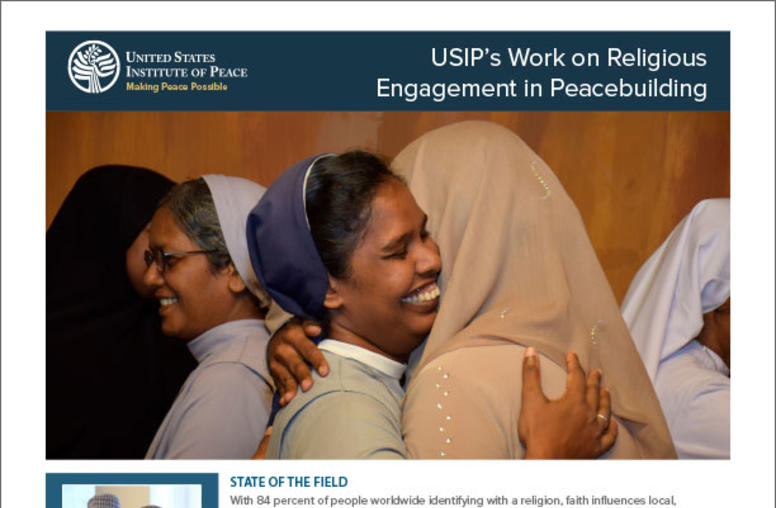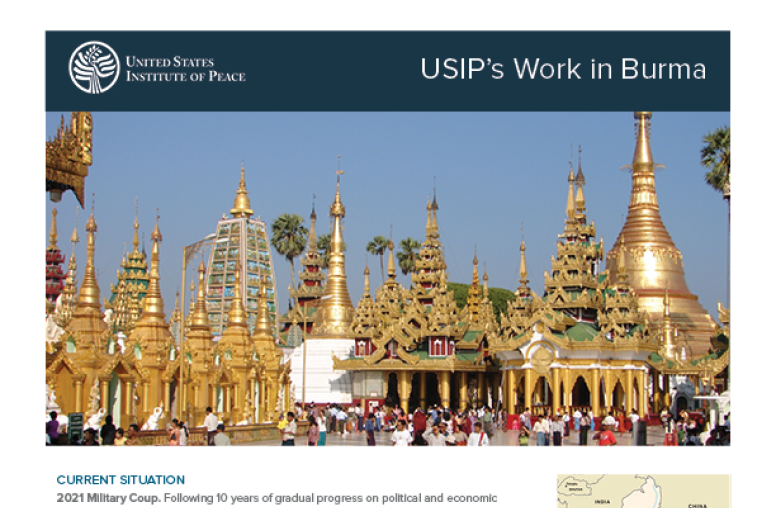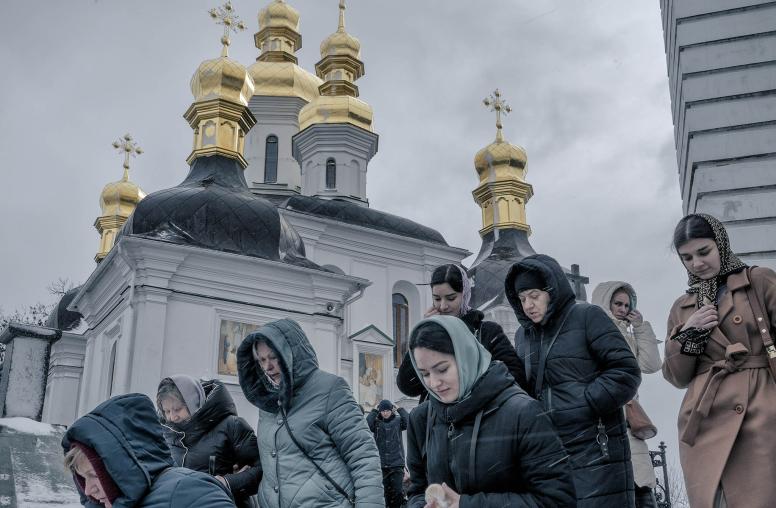New Evidence: How Religion Aids Peaceful Change
Nonviolent movements are effective in building peace. Religion may help them more than we think.
The pullback in 2021 of international military operations in Afghanistan, Iraq and Africa’s Sahel region not only shows the limits of such foreign interventions. It forces policymakers to more urgently examine other ways to support the sustainable social changes that can stabilize violence-stricken nations. New USIP research sharpens an insight about one powerful method to achieve such changes—nonviolent, citizens’ movements that improve governance and justice. Effectively, the research shows, religion helps more often than we may think. Of more than 180 nonviolent campaigns for major political change since World War II, a majority have involved religion in some way.

While peace activists across decades have drawn on religion to drive movements for justice and human rights, public and policy debates these days more often discuss religion’s links to violence and extremism. To broaden that conversation, USIP’s Religion and Nonviolent Action project researches ways to better harness the power of religious belief and institutions in preventing violence and extremism, and in stabilizing nations and communities in conflict. A current thread of that research analyzes what roles religion plays in nonviolent resistance.
Religion’s Help for Nonviolent Campaigns
For generations, religion has been a persistent, prevalent part of popular movements seeking social justice and peace. In the U.S. civil rights movement, leaders such as the Reverend Martin Luther King, Jr., organizations such as the Southern Christian Leadership Conference, and black churches – all played roles in developing and coordinating the movement’s nonviolent strategy. In Liberia, a women’s movement for peace mobilized participants from Christian and Muslim organizations with song, prayer, and fasting, among other protest tactics, to help end the country’s brutal civil war. The 2011 Arab uprisings saw mosques frequently become sites of mobilization following Friday prayers. Hong Kong’s pro-democracy movement used religious symbols, making a Christian hymn an anthem in 2019. In Myanmar, Buddhist monks marched with laypeople protesting the February 2021 military coup. Religious leaders and institutions have mediated between protest movements and governments to seek peaceful solutions, as in Colombia.
USIP research starting in 2020 identified six distinct ways in which demonstrators have drawn on religion to advance peace processes—through ideas, people, institutions, symbols, spirituality and external support. Our study included major global religions, such as Buddhism, Christianity and Islam, as well as traditions such as animism and indigenous religions. We used a database developed by nonviolent action scholar Erica Chenoweth, the Nonviolent and Violent Campaigns and Outcomes Project, that catalogues the world’s major campaigns for social or political change from 1900 to 2013. We identified and classified the religious dimensions of 183 nonviolent action campaigns with maximalist goals (i.e., overthrowing a regime or expelling a foreign military force) from 1945 to 2013. Of these, 58 percent had at least one religious dimension that contributed to a campaign. Our initial analysis also points to two patterns that call for further investigation.
Religious Institutions’ Roles
One dimension of religious engagement with movements appears to contribute in particular to their success. This is the support of religious institutions, including mosques, churches, temples, faith-based aid organizations, parochial schools and faith-based civil society groups. Most cases of religious institutional support in our dataset were linked to Christianity, specifically Catholicism. Where nonviolent movements had support from religious institutions, they were more than twice as likely to achieve their goals than movements without such support.
While our study covered only 16 movements with religious institutional support its findings align with previous studies on the roles of the Roman Catholic Church in supporting nonviolent movements such as those of the 1980s in Poland and the Philippines. Poland’s Solidarity movement used street protests, strikes, satire, vigils and Catholic masses to challenge communist rule, working in alliance with the Catholic church. When the regime imposed martial law, Catholic churches provided refuge for Solidarity activists from authorities, and the church’s role was vital in achieving a peace accord, elections and the end of communist rule in 1989.
In the Philippines, the Catholic church provided similar leadership, popular legitimacy, organizing resources and communications—notably through its nationwide radio station, Radio Veritas. Catholic bishops, including Cardinals Jaime Sin and Ricardo Vidal, summoned public support at critical moments for the secular, nonviolent movement opposing the dictatorship of Ferdinand Marcos. In the climactic confrontation, priests and nuns stood in the front ranks of massed protesters confronting Marcos’ soldiers and tanks, providing vital protection for senior Marcos military aides who had defected to the opposition, splitting the military and ensuring Marcos’ ultimate flight from power.
In many countries, the Catholic church can use its strong connections to communities and institutional ties to governments to play key mediating roles. These roles by the church reflect how other religious institutions as well can be uniquely positioned to support nonviolent citizens’ movements. The vital attributes they can offer include deep roots in communities, established networks across societies, and organizational structures and resources that can offer direct support for activists.
The Newly Urgent Questions
The exposition of this broad, 70-year pattern of religious power for nonviolent change focuses new questions for policymakers and for practitioners of peacebuilding. How can governments, organizations and peacebuilders broaden the opportunities—and the chances of success—for religion in this role? In particular, how can they better understand the religious landscape of conflict zones and fragile states, and thus the fuller picture of forces at play in nonviolent uprisings?
Other questions more directly address religious institutions and other actors themselves. How might they better promote the inclusive, sustainable outcomes that redress injustice and achieve needed social, political, and economic changes? Can religious factors better help groups to mobilize in the first place? Are movements that draw on religion more likely to stay committed to nonviolent tactics? And how might spiritual ideas and practices help groups overcome setbacks? Our initial analysis underscores the relevance of this last question. Nonviolent movements that drew on religion in our dataset lasted about a half-year longer than their nonreligious counterparts. Is this because faith buttresses resiliency?
Our historical moment gives new urgency to these questions for activists, peace practitioners, and U.S. and international policymakers. New hope and opportunity for building peace is blossoming in nonviolent movements for change—in places as diverse as Burma, Sudan, and the United States—that seek the vital support that religion can provide.
Sandra Tombe is a research assistant at the U.S. Institute of Peace.



